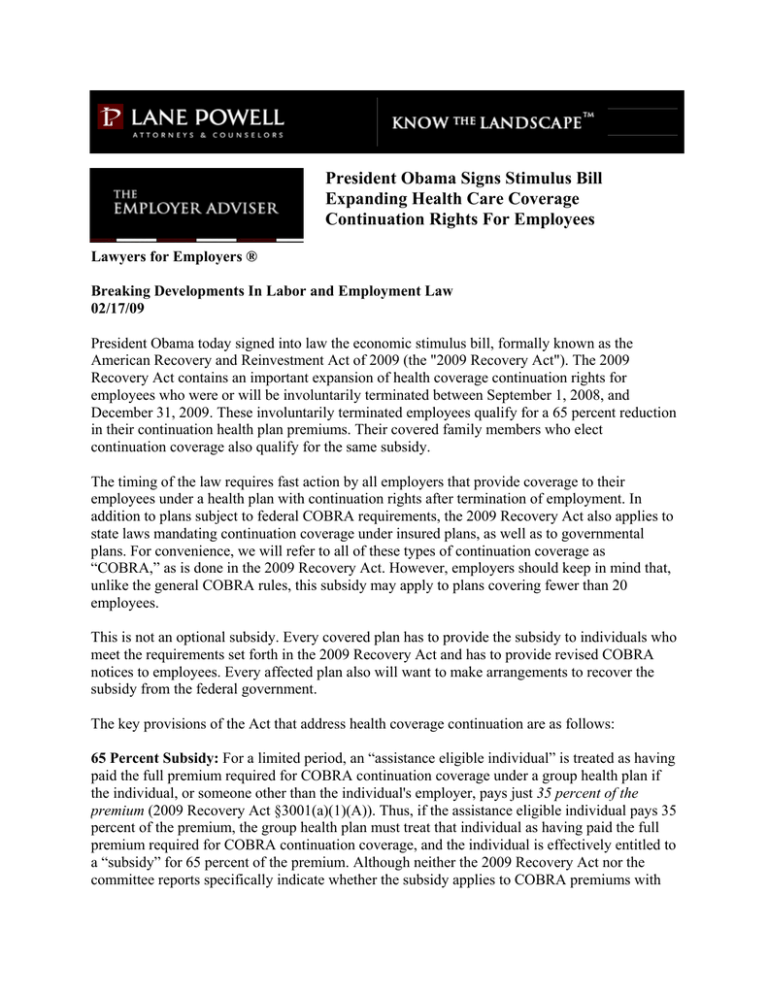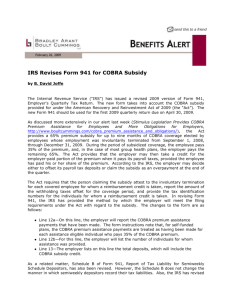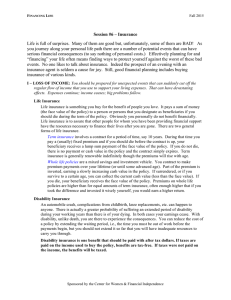President Obama Signs Stimulus Bill Expanding Health Care Coverage
advertisement

President Obama Signs Stimulus Bill Expanding Health Care Coverage Continuation Rights For Employees Lawyers for Employers ® Breaking Developments In Labor and Employment Law 02/17/09 President Obama today signed into law the economic stimulus bill, formally known as the American Recovery and Reinvestment Act of 2009 (the "2009 Recovery Act"). The 2009 Recovery Act contains an important expansion of health coverage continuation rights for employees who were or will be involuntarily terminated between September 1, 2008, and December 31, 2009. These involuntarily terminated employees qualify for a 65 percent reduction in their continuation health plan premiums. Their covered family members who elect continuation coverage also qualify for the same subsidy. The timing of the law requires fast action by all employers that provide coverage to their employees under a health plan with continuation rights after termination of employment. In addition to plans subject to federal COBRA requirements, the 2009 Recovery Act also applies to state laws mandating continuation coverage under insured plans, as well as to governmental plans. For convenience, we will refer to all of these types of continuation coverage as “COBRA,” as is done in the 2009 Recovery Act. However, employers should keep in mind that, unlike the general COBRA rules, this subsidy may apply to plans covering fewer than 20 employees. This is not an optional subsidy. Every covered plan has to provide the subsidy to individuals who meet the requirements set forth in the 2009 Recovery Act and has to provide revised COBRA notices to employees. Every affected plan also will want to make arrangements to recover the subsidy from the federal government. The key provisions of the Act that address health coverage continuation are as follows: 65 Percent Subsidy: For a limited period, an “assistance eligible individual” is treated as having paid the full premium required for COBRA continuation coverage under a group health plan if the individual, or someone other than the individual's employer, pays just 35 percent of the premium (2009 Recovery Act §3001(a)(1)(A)). Thus, if the assistance eligible individual pays 35 percent of the premium, the group health plan must treat that individual as having paid the full premium required for COBRA continuation coverage, and the individual is effectively entitled to a “subsidy” for 65 percent of the premium. Although neither the 2009 Recovery Act nor the committee reports specifically indicate whether the subsidy applies to COBRA premiums with or without the addition of the 2 percent administration fee, the language in the law implies that the premium reduction subsidy is based on the full 102 percent (e.g., if premium with 2 percent administration fee is $102, then the subsidized COBRA premium is 35 percent of $102, or $35.70). Eligibility: An assistance-eligible individual is any qualified beneficiary if all of the following are true: • • • at any time from September 1, 2008, through December 31, 2009, the qualified beneficiary is eligible for COBRA continuation coverage; elects COBRA continuation coverage; and the qualifying event giving rise to the beneficiary's COBRA eligibility consists of the involuntary termination of a covered employee's employment during this period. (2009 Recovery Act §3001(a)(3)). Second-Chance Elections: Employees who were involuntarily terminated between September 1, 2008, and the date of enactment but initially failed to elect COBRA are given an additional 60 days to elect COBRA and receive the subsidy. A qualified beneficiary who elected COBRA coverage before the date of enactment, but who is no longer enrolled on the date of enactment (e.g., because the qualified beneficiary was unable to afford the premium), is entitled to elect COBRA coverage during this extended election period. These second-chance elections do not provide for retroactive COBRA coverage, and they do not extend the maximum coverage period under COBRA (which is measured from the initial qualifying event). The 60-day election period starts to run on the date the qualified beneficiaries receive notice of the second-chance election right. Election Notices. Notice of the premium subsidy must be provided to qualified beneficiaries who first become eligible for COBRA during the subsidy period. Also, within 60 days after the date of enactment, the plan administrator must provide the subsidy notification to any individual who is entitled to a second-chance election. The notice requirements are detailed and specific, and the 2009 Recovery Act requires the Department of Labor to develop model notices within 30 days after the date of enactment. Each election notice must include: • • • • • the forms necessary for establishing eligibility for premium reduction; the name, address and telephone number of the plan administrator and any other person maintaining relevant information in connection with the premium reduction; a description of the second election period; a description of the obligation of the qualified beneficiary to notify the plan providing continuation coverage of eligibility for subsequent coverage under another group health plan or Medicare, and the penalty (110 percent of the reduced premium) for failure to do so; a description, displayed in a prominent manner, of the qualified beneficiary's right to a reduced premium and any conditions on entitlement to the reduced premium; and 2 • a description of the option of the qualified beneficiary to enroll in different coverage offered under the plan, if permitted by the employer. (2009 Recovery Act §3001(a)(7)(B)). Coverage Change: The plan may, but is not required to, allow an assistance-eligible individual to change coverage from the health plan coverage option in effect at the time of the qualifying event to an equal or lower cost coverage option. This is different from the general COBRA rule that continuation coverage is the same coverage that was in effect as of the date of qualifying event. If the plan offers this option, then the new election must be made within 90 days after receiving notice of the availability of this option from the plan. Duration of Subsidy: An assistance-eligible individual is eligible to receive a COBRA premium assistance subsidy until the earlier of: • • the first date that the individual is eligible for coverage under any other group health plan (other than coverage consisting of only dental, vision, counseling or referral services, or a combination thereof), coverage under a health reimbursement arrangement or a health flexible spending arrangement, or coverage of treatment that is furnished in an on-site medical facility maintained by the employer and that consists primarily of firstaid services, prevention and wellness care, or similar care (or a combination thereof); or the first date that the individual is eligible for benefits Medicare; or the earlier of (i) the date that is nine months after the first day of the first month that the subsidy becomes available to the individual; or (ii) the date following the expiration of the maximum period of continuation coverage required under the applicable COBRA continuation coverage provision. (2009 Recovery Act §3001(a)(2)(A)). Reimbursement of Subsidy: Although the qualified beneficiary receives full COBRA coverage after paying just 35 percent of the premium, the plan does not have to permanently subsidize the remaining 65 percent of the premium. The subsidy is paid by the federal government. The mechanism for recovering the subsidy is the payroll tax. In the case of a self-funded plan, the employer sponsoring the plan is entitled to the reimbursement. In the case of an insured plan, the insurer providing the coverage is entitled to the reimbursement. After filing a claim for reimbursement as prescribed by the IRS, the person entitled to the reimbursement shall be treated as having paid payroll taxes in an amount equal to the portion of the reimbursement that relates to subsidized premium. The claim for reimbursement cannot be filed until the person claiming the reimbursement has received the reduced premium payment from the assistance eligible individual. 3 The reimbursement is not available to the extent that an employer paid the COBRA premium on behalf of the terminated employee, as is commonly the case in connection with severance packages. The IRS is reportedly working feverishly on revisions to Form 941 so that it includes the necessary information to claim reimbursement of the 65 percent subsidy. Subsidy Not Taxable to Individual, Unless High Income: Generally, the amount of the COBRA subsidy is not taxable income to the taxpayer. However, if the COBRA premium subsidy is provided to a taxpayer (or to his/her spouse or dependents) during a taxable year when the taxpayer's modified adjusted gross income exceeds $145,000 (or $290,000 for joint filers), then the amount of the premium subsidy for all months during the taxable year must be repaid. This is the responsibility of the taxpayer, not the plan. However, the plan must provide highly compensated individuals an opportunity to permanently opt out of the COBRA premium subsidy (presumably so they don't have the problem of receiving the subsidy and then having to repay it). Future guidance will explain how the plan has to make this option available to employees. What This Means for Employers The 2009 Recovery Act requires quick action by all employers who provide coverage to their employees under a health plan with continuation rights after termination of employment. Because the Act's provisions apply not only to plans subject to federal COBRA requirements, but also to state laws mandating continuation coverage under insured plans, as well as to governmental plans, employers should be aware that the Act's premium subsidy may apply to plans covering fewer than 20 employees. Among other things, health plans which are covered by the Act will need to take steps to (i) ensure payment of the premium subsidy on behalf of qualifying individuals, (ii) provide revised COBRA notices to those individuals, and (iii) file a claim for reimbursement of the subsidy from the federal government. As a result, employers are strongly encouraged to review their health plans and establish protocols to comply with the requirements of the Act with regard to its subsidy provisions. For more information, please contact the Labor and Employment Law Practice Group at Lane Powell: 206.223.7000 Seattle 503.778.2100 Portland 907.277.9511 Anchorage employlaw@lanepowell.com www.lanepowell.com We provide Employer Adviser as a service to our clients, colleagues and friends. It is intended to be a source of general information, not an opinion or legal advice on any specific situation, and does not create an attorney-client relationship with our readers. If you would like more information regarding whether we may assist you in any particular matter, please contact one of our lawyers, using care not to provide us any confidential information until we have notified you 4 in writing that there are no conflicts of interest and that we have agreed to represent you on the specific matter that is the subject of your inquiry. Copyright © 2009 Lane Powell PC Seattle - Portland - Anchorage - Olympia - Tacoma - London 5


